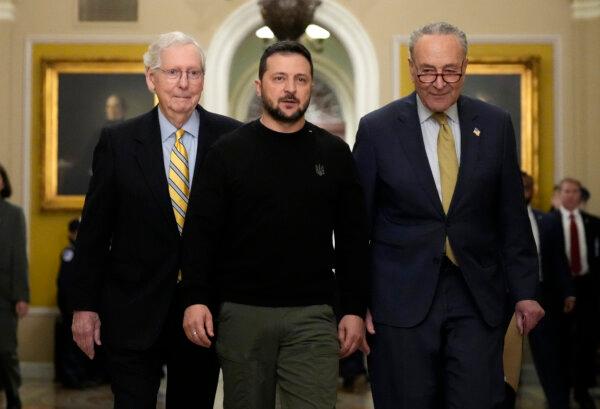

John Haughey, Author (Reporter) Epoch Times
Submitted by Grady Norwood, Jr.
House Speaker Mike Johnson (R-La.) at the U.S. Capitol in Washington on Dec. 6, 2023. (Win McNamee/Getty Images)
Mr. Schumer said the Senate’s overwhelming 87-13 vote to move the defense budget “shows the momentum for finishing the NDAA quickly,” adding, “I urge House Speaker Johnson and the House to move this bill quickly.” While much of the attention, and blame, for delayed budget adoptions focused on House Republicans’ repeated displays of workplace dysfunction, Sen. John Cornyn (R-Texas) said Mr. Schumer has also contributed to the gridlock.
Mr. Cornyn said Senate committees passed all 12 budget bills before adjourning for August recess, yet none of the approved packages were presented on the Senate floor until mid-September, within days of the Oct. 1 fiscal new year. “So at the end of the end of the fiscal year, which was the end of September, we had to pass a short-term continuing resolution to fund the government until November.” And then, he said, “that November deadline came and went once again, we had to kick the can down the road once more to Jan. 19” next year.
Mr. Cornyn said the NDAA “should have been signed into law by the end of September, but the majority leader decided to delay it until now. We will finally complete that work either later today or tomorrow,” leaving the House little time to weed through the bill. The NDAA moves onto a House roiling in conservative angst where it remains to be seen if it will meet Pentagon pleas to get an approved defense budget to President Joe Biden’s desk before year’s end. The NDAA reported out of conference committee Dec. 6 and approved by the Senate Dec. 12, is nothing like the Department of Defense (DOD) spending plan the House adopted in a July partisan vote.
Excluded from the draft NDAA are House amendments banning the DOD’s paid leave policy for service members traveling for abortions, gender-transition treatments and surgeries for transgender service members and their families, and funding for on-base drag shows. Remaining in the NDAA are House amendments that defund critical race theory programs and hiring for diversity, equity, and inclusion positions. Also included is a provision requiring the DOD to consider reinstating service members discharged for refusing COVID vaccinations.
FISA Fuss
But whereas the FISA Section 702 extension drew flak in the Senate, it is a lava lamp for bipartisan critics in the House, especially among the 40-member House Freedom Caucus. FISA’s Section 702 language allows the National Security Agency to intercept broad swaths of foreign communications without individualized court orders.
While such surveillance is outlawed on U.S. citizens, Americans’ private conversations are inevitably swept into national security probes into foreign communications, say critics who warn Section 702 provides federal agencies a “backdoor” way to ferret through Americans’ names and email addresses in foreign targets’ intercepted communications.
In a Dec. 7 “Dear Colleagues” letter, Speaker Mike Johnson (R-La.) said that extending FISA through April 19 will “provide the necessary time to facilitate the reform process in a manner that will not conflict with our existing appropriations deadlines and other conflicts,” implying it is a small concession to ensure the “must-pass” NDAA is adopted. The response from the Freedom Caucus wasn’t encouraging. “The members of the House Freedom Caucus are prepared to use all available leverage to change the status quo. We will not simply vote ‘no’ on bad legislation and go home for Christmas,” it said in a statement.
During discussion on Sen. Rand Paul’s (R-Ky.) point-of-order motion to suspend the FISA extension, Mr. Cornyn said FISA Section 702 is described by intelligence officials as “the crown jewel of American intelligence-gathering because it’s absolutely vital to our national security.” He said the provision “allows the intelligence community to obtain information with which to combat everything from terrorism, to cyber-attacks, and to prevent our adversaries from developing weapons of mass destruction.”
Mr. Cornyn called the extension and eventual FISA reauthorization “a critical national security tool” that cannot be allowed to expire on Dec. 31. “Our nation’s most senior intelligence officials have been pleading with Congress for months to take action,” he said. “They’ve issued warnings in the starkest possible language about the consequences of failing to reauthorize Section 702. “They would have us believe that Armageddon will immediately be upon us, dogs and cats living together in the streets, wrath of God, apocalyptic stuff like we’ve never experienced. Why? Because FISA 702 will have gone dark,” Sen. Mike Lee (R-Utah) said. “The problem with that argument?” he asked. “It’s not true.”
Sen. Mike Lee (R-Utah) speaks at a news conference on government spending at the U.S. Capitol in Washington on Dec. 7, 2022. (Anna Moneymaker/Getty Images)
Under the FISA, he said, a Foreign Intelligence Surveillance Act Court can issue a surveillance warrant for up to a year after any authorization expires.
The 702 extension “buried within the 3,000 or so pages of the National Defense Authorization Act would give them a bright and golden opportunity to make this not a four-month extension of FISA Section 702, but a 16-month extension,” Mr. Lee said. He argued the FISA extension should be debated separately and that the conference report is precluded from adding anything to a draft budget not submitted by the chambers. Neither proposed NDAA addressed FISA.
“We shouldn’t be reauthorizing this, not in the NDAA,” Mr. Lee said. “Not only is it not germane [to the defense budget], not only was it not in the House version, nor in the Senate version, it’s not even necessary,” calling on the chamber to “strike this unnecessary, over-broad, and manipulative extension of FISA 702” from the NDAA.
Mr. Paul said FISA and the Foreign Intelligence Surveillance Act Court are both flatly unconstitutional threats to individual civil liberties under the Fourth Amendment. “The Supreme Court has ruled that national security does not require secret courts, or justify ignoring Fourth Amendment liberties,” he said. The FISA authorization “trusts America’s intelligence agencies with broad authorities, supposedly to surveil foreigners abroad. But time has proven, again and again, that America’s intelligence agencies cannot be trusted with this immense power and responsibility,” Mr. Paul said.
Congress has known for five years that FISA’s Section 702 expires on Dec. 31, 2023, he said.
“Yet, somehow, the Senate has no time to debate this and wishes to simply extend it,” Mr. Paul said. “Everything’s rush, rush, rush, let’s pass it without debate. But they have known for five years it was going to expire at the end of this year and yet they just want to pass it with a hope that they’ll never have to debate it.”
What’s In the NDAA

The NDAA earmarks $841.5 billion for the DOD—nearly $32 billion, or 3 percent, more than the FY23 NDAA; $32.26 billion for the National Nuclear Security Administration; and $12.1 billion in defense-related allocations for other federal agencies. Included is a 5.2 percent pay raise for service members, a trilateral nuclear-powered submarine pact with Britain and Australia (AUKUS), initiatives to counter Russia in Europe, foil communist China in the Pacific, aid Israel in the Middle East, investmenting in newly created Space Force, and investment in technologies including artificial intelligence and hypersonics.
“It’ll give Americans, men and women in uniform, a pay raise,” Mr. McConnell said. “It’ll focus the Pentagon more squarely on national security challenges instead of creating new ones with partisan social policies.” Mr. Schumer called the AUKUS deal “an historic agreement [that] will create a new fleet of nuclear powered submarines to counter the Communist Party’s influence in the Pacific.” Under the draft budget, the Navy would receive $255.8 billion—an addition of $11 billion, or 4.5 percent, from FY23, for a 291 battle-force ship fleet, 347,000 active duty sailors and officers, and 57,200 reservists.
The U.S. Marine Corps’ $53.2 billion FY24 draft plan calls for 172,300 active-duty Marines and 33,600 Marine Corps reservists personnel. A third of the Navy’s $255.8 billion FY24 budget—$84.6 billion—is dedicated to operations, deployment, and training; a 3.8-percent increase from FY23’s operational tempo.The NDAA’s $77 billion Navy procurement plan includes $32.9 billion to build eight new warships and submarines, and $17.3 billion for building 88 new aircraft. The bill authorizes keel-laying for a Columbia class ballistic submarine, two Virginia class attack submarines, two Flight III Arleigh Burke-class guided-missile destroyers, two new Constellation class guided-missile frigates, and a John Lewis-class fleet oiler for a total of eight battle force ships authorized in the draft.
As of November, the Congressional Budget Office (CBO) reports that the Navy has 291 battle-force ships. The service’s future force structure was updated to 381 ships in early 2023, up from the 355-ship fleet goal adopted in the FY18 NDAA. By statute encoded in previous NDAAs, the Navy is required to have no less than 11 aircraft carriers and 31 amphibious warfare ships, with at least 10 being LHA/LHD-type “big deck” amphibious assault ships.
The Air Force’s $215.1 billion budget is $9.3 billion, or 4.5 percent, more than its FY23 plan. Its projected 512,100-member force structure includes Air Force active duty, Guard and Reserve airmen, and Space Force active duty airmen. Air Force’s $35.4 billion procurement request is a $1.2 billion increase over FY23 and adds $1 billion to grow the F-35A fighter fleet by 48 aircraft, adds $518 million to procure 15 KC-46 tankers, and $317 million for 24 F-15 E/Xs.
“Above all,” Sen. John Thune (R-S.D.) said, he was “pleased with authorization of funding for the B-21 bomber plane program, which will be located in my state at Ellsworth Air Force Base.”

The draft NDAA permits the Air Force to retire 42 A-10 Warthogs to be replaced by F-35s, which infantry advocates say is not as good for close air support, retire F-16 C/D fighters, retire no more than 68 F-15Es through 2029, but maintain a minimum fighter inventory of 1,112.
Among key programs outlined in the Army’s $185 billion NDAA is more than $70 billion for tactical missile defenses “across all realms” and significant boosts in anti-missile defense. Other NDAA Army highlights include up to $1.2 billion to upgrade M1 Abrams, $500 million more than Biden administration’s request; $674 million for the Self-Propelled Howitzer Paladin Integrated Management (PIM) program, a $205 million boost over Army’s initial request; $380 million to buy CH-47 Chinook helicopters, $177.5 million above the Army’s request for four additional heavy-lift helicopters; and $41 million for CH-47F Block II advanced procurement, $22.5 million more than the Army’s request.

